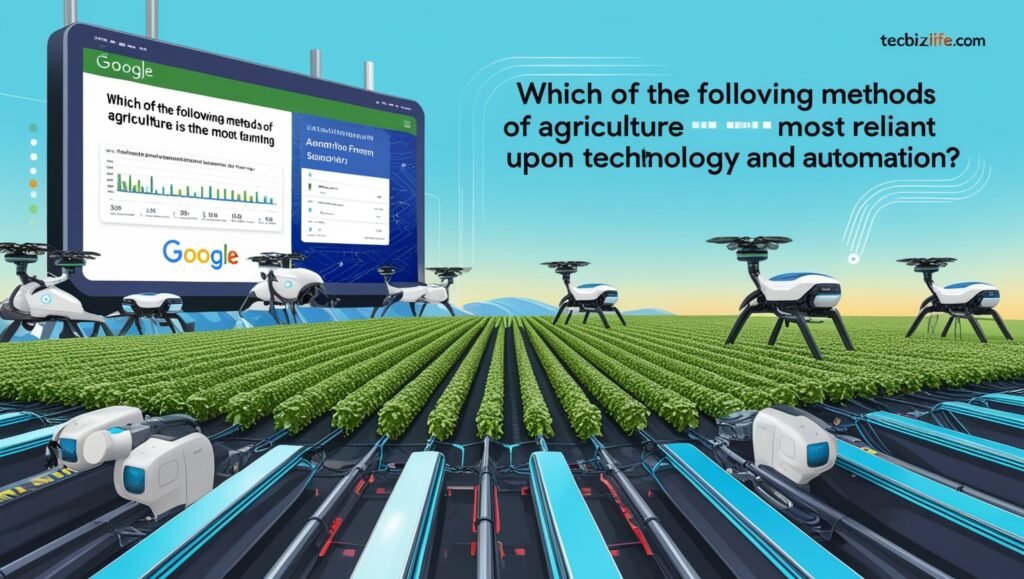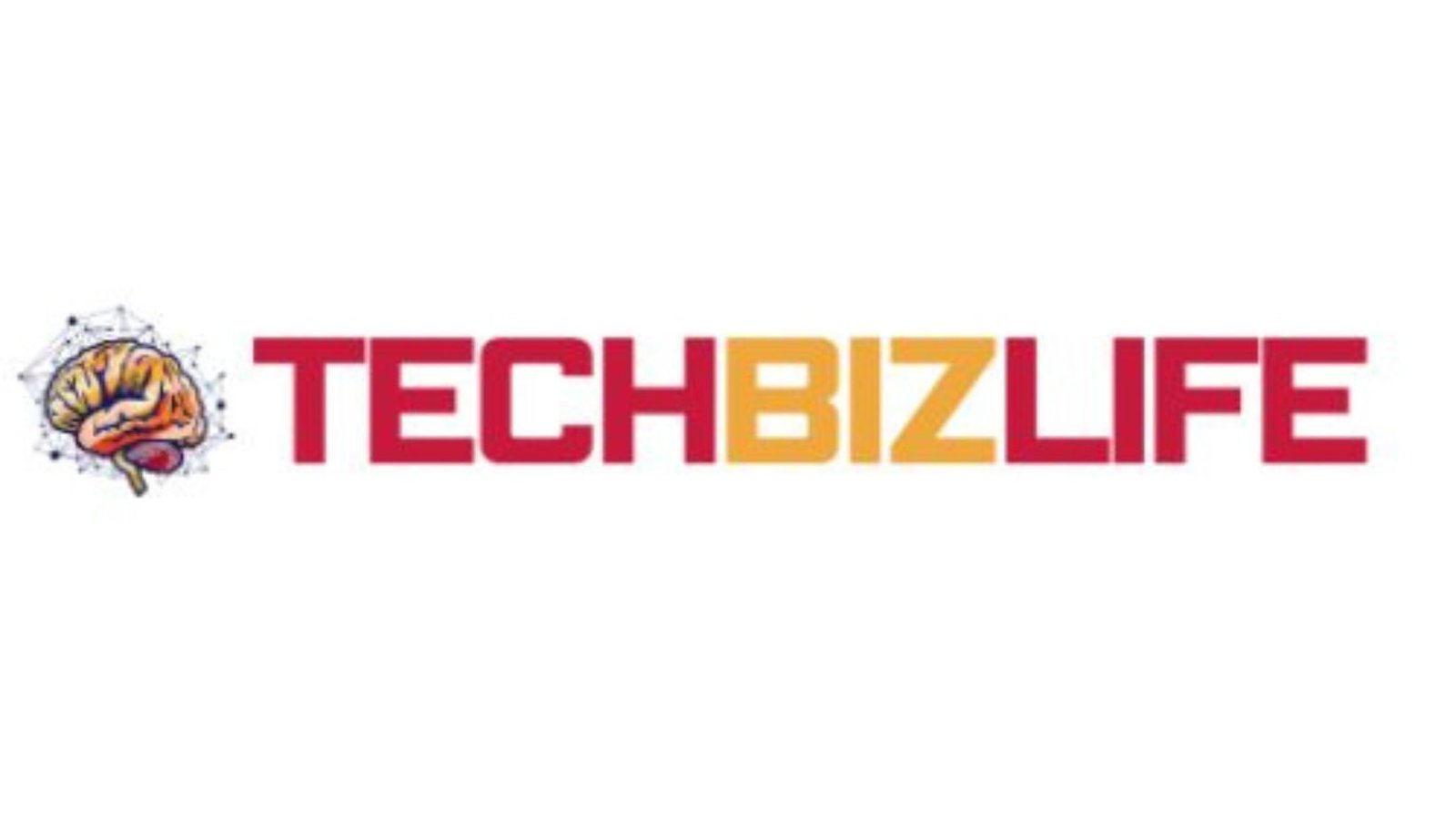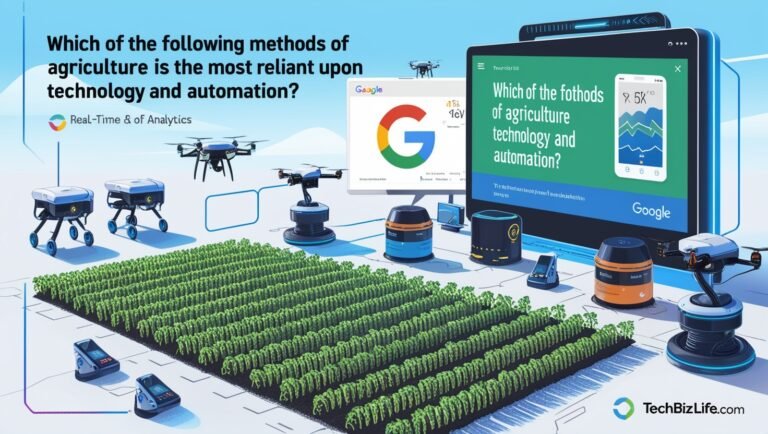Which of the following methods of agriculture is the most reliant upon technology and automation? The agricultural industry has gained a rapid pace of improvement in the technology and automation involved for the last few years. Indeed, they helped change old traditions, allowing for high efficiency and minimized waste in cultivation for greater production compared to what was impossible years ago. However, different farming systems are reliant on more significant amounts of technology. The following is a list of the predominant agriculture practices that rely highly on technology and mechanization; how they implement such related to technological innovations as it affects crop yield and output.
Key Takeaways
- Precision Agriculture Leads Automation in Farming: Combining GPS, sensors, and data analysis, precision farming is the top tech-driven agriculture method.
- Hydroponics is Powered by Automation: Hydroponic farms rely on automated nutrient systems and pH control to optimize crop growth.
- Vertical Farming Leverages Environmental Controls: Automated climate systems, lighting, and water control are essential to high-efficiency vertical farms.
- Drones and IoT Sensors in Modern Agriculture: Drones offer a comprehensive approach to crop monitoring, and IoT sensors deliver real-time data to enhance farm management.
- Big Data in Agriculture: Data analytics boosts productivity, helping farmers make evidence-based decisions for greater efficiency.
Precision Agriculture: Greatest Technology and Mechanized farming system
Precision agriculture, or “smart farming,” uses technology to monitor crop health, soil quality, and environmental conditions. Farmers can make precise adjustments to improve yields based on this information. It is considered the most advanced and technology-reliant agricultural method today.
Key Technologies in Precision Agriculture
Precision agriculture integrates several high-tech tools to enhance precision and productivity:
| Technology | Description |
|---|---|
| GPS Guidance Systems | Used for mapping fields and ensuring accurate seed placement, pesticide application, and watering. |
| IoT Sensors | Monitor soil moisture, nutrient levels, and crop health for optimized input use. |
| Variable Rate Technology (VRT) | Adjusts fertilizer, water, and pesticide levels based on real-time data from field sensors. |
| Data Analytics Platforms | Analyze sensor data to provide actionable insights for farm management decisions. |
Statistics Supporting Precision Agriculture
- According to USDA statistics, 80% of U.S. large farms were using some form of either GPS or IoT technologies towards improving productivity and efficiency in their operations.
- According to McKinsey, a 40% reduction in the consumption of fertilizers and an increase of 10–15% in crop yield due to optimized input levels.

Precision agriculture shows to cut the costs and increased profitability since everything about the agriculture process is optimized by using this technology.
Also Learn More: which of the following methods of agriculture is the most reliant upon technology and automation?
Hydroponics
Which of the following methods of agriculture is the most reliant upon technology and automation?Hydroponics A Future Farming Approach Without Needing Soil Hydroponic farming is the newest version of growing plants. Hydroponics involves a system using water, and not earth, to supply crops and other plants with all their nourishment. Automations form an integral part of the hydroponic farming, nutrient levels, the balance of acidity and alkaline in hydroponics solution, or water must constantly be tracked and controlled
| System | Function |
|---|---|
| Automated Nutrient Control | Dispenses the exact amounts of nutrients plants need, reducing waste and maximizing growth. |
| pH Monitoring Sensors | Maintain ideal pH levels to ensure optimal nutrient uptake by plants. |
| Water Circulation Systems | Keep nutrient solution evenly distributed to all plants, promoting consistent growth. |
| Artificial Lighting Controls | Provides plants with sufficient light, simulating natural sunlight cycles. |
Adoption and Efficiency of Hydroponics
Which of the following methods of agriculture is the most reliant upon technology and automation?Hydroponics is rapidly increasing, with the world market projected to reach $16 billion by 2025. Automation allows hydroponic farms to achieve yields that are 25% higher than those on traditional agriculture, notes a report by Grand View Research. This higher yield is at much lower water use rate: hydroponic systems could cut water use by as much as 90%.
Vertical Farming: Stackable, Controlled Environment Agriculture
Vertical farming is an agricultural practice where crops are grown in vertically stacked layers and often in controlled environments. Automation is required to control factors like temperature, light, and humidity for the plants to grow inside with minimal or no direct sunlight and soil.

Automation Role in Vertical Farming
| Technology | Description |
|---|---|
| Climate Control Systems | Automated systems regulate temperature, humidity, and CO2 levels for optimal growth. |
| LED Lighting | Programmable lighting provides crops with the right spectrum and intensity of light. |
| Watering Systems | Sensors track water needs and distribute water precisely to each plant, conserving resources. |
| Nutrient Delivery Systems | Automatically administers nutrients based on real-time plant needs. |
Market and Efficiency Data
- The vertical farming market will grow at a rate of 24% annually to reach $21 billion by 2030 (Allied Market Research).
- According to the U.N. Food and Agriculture Organization (FAO), automated vertical farms save 90% of water and can yield up to 300% more crops per square foot than conventional farms.
Urban areas with limited space find vertical farming an attractive choice, especially because the reliance on technology makes it a sustainable way to produce crops throughout the year.
Drone Technology in Smart Agriculture
Drones have been very much in use in agriculture for crop monitoring, mapping, and data collection. It enables farmers to have an overall view of their crops and, with this view, they are able to make timely, data-driven decisions about irrigation, pesticide application, and many other crop management practices.
Applications of Drones in Agriculture
| Application | Benefit |
|---|---|
| Crop Health Monitoring | Captures detailed images that reveal crop stress, pest infestations, and nutrient levels. |
| Irrigation Management | Uses thermal cameras to detect water-stressed areas, ensuring efficient water distribution. |
| Pesticide Application | Drones apply pesticides precisely where needed, minimizing environmental impact. |
| Field Mapping | Provides aerial mapping for more accurate field planning and management. |
The Impact of Drones on Agriculture
The agricultural drone market will be approximately $5.7 billion by 2027, which means tremendous adoption in countries such as the U.S., Brazil, and China. Using drones-based pesticide application reduces the utilization of chemicals by 30%. That’s really more efficient and environmental-friendly compared to chemical application.
Also Learn More: which of the following methods of agriculture is the most reliant upon technology and automation?
Big Data and IoT: Real-time Insights for Data-Driven Agriculture
Big data and the Internet of Things are transforming agriculture, offering insights that guide farmer decisions. IoT sensors collect large amounts of data about soil, crop, and environmental conditions and analyze them to improve productivity and optimize resource use.
Applications of Big Data and IoT in Agriculture
| IoT Technology | Function |
|---|---|
| Soil Moisture Sensors | Measure moisture levels, helping farmers optimize irrigation. |
| Weather Sensors | Provide localized weather information, aiding in irrigation and planting decisions. |
| Crop Health Sensors | Track crop growth, detect pests, and help farmers apply timely interventions. |
| Analytics Platforms | Process data from various sensors, delivering actionable insights for farm management. |
Benefits of Data-Driven Agriculture
Which of the following methods of agriculture is the most reliant upon technology and automation?International Food Policy Research Institute published a report stating data-driven agriculture improves productivity 25% when resources are fully utilized without crop loss. With IoT and big data, response to data in real-time allows for low cost, more profitability and higher sustainability for agriculture amidst the climate changes.
FAQs

Which agricultural method is most dependent on technology and automation?
Precision agriculture is the most dependent on technology, using GPS, IoT sensors, and data analytics to optimize every aspect of farming.
How do drones enhance agricultural efficiency?
Drones offer aerial views for crop monitoring, irrigation management, and targeted pesticide application, reducing waste and labor costs.
Is hydroponics sustainable?
Yes, it is a very efficient and sustainable form of farming that only uses 90% the water of soil-based traditional farming.
What is the role of big data in modern agriculture?
It enables farmers to make informed decisions based on real-time insights, thereby increasing productivity while reducing resource usage.
Can small farms benefit from vertical farming?
Yes, even smaller farms can use vertical farming in exploiting limited spaces, but initial costs without access to financing might be a challenging factor.
Conclusion
The most transformative solution is technology and automation when agriculture cannot feed a burgeoning population or change with climatic shift. Methods such as precision agriculture, hydroponics, and vertical farming show promise in using highly advanced tools to increase yields, optimize efficiency, and raise sustainability levels. These technological approaches to farming not only reduce waste and optimize use of all resources but make farming even more resilient and profitable. As the agricultural industry continues its innovation, reliance on technology will only


